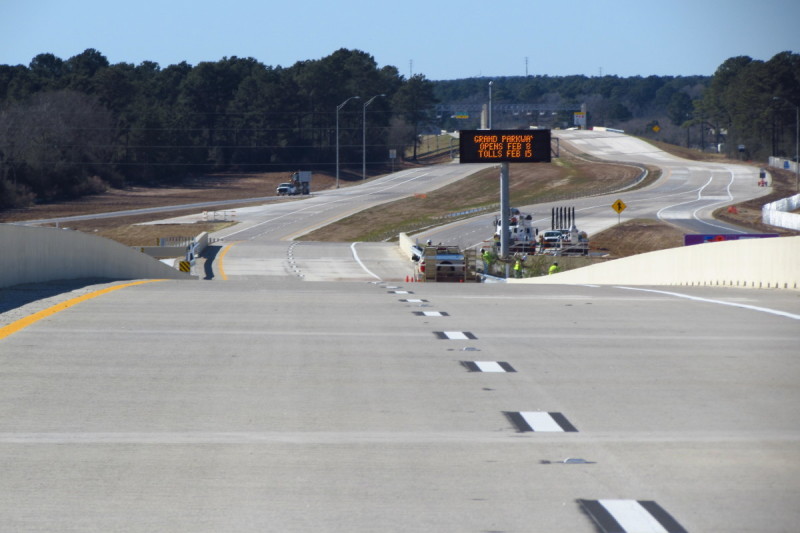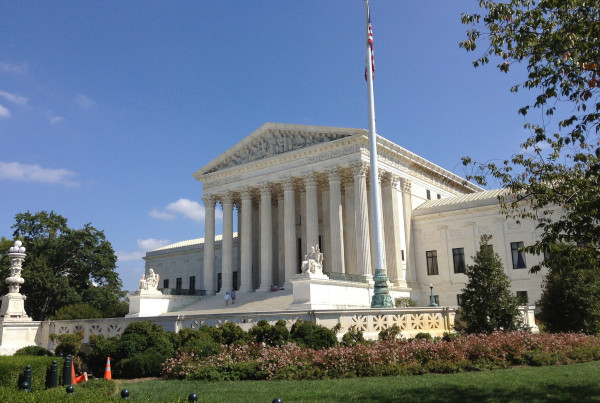This story originally appeared on Houston Public Media.
Susan Richardson knows all too well about the congestion in northwest Harris County. She drives from her home in Cypress to her job at Southwestern Energy, just off I-45 in Spring. It’s about a 20 mile trip.
Richardson says the morning commute isn’t so bad, but in the afternoon it can take twice as long to get home.
So what’s the holdup?
“All the stoplights between my office and my house – there’s 31 of them,” says Richardson. “I counted them one day.”
Richardson is hoping those frustrating commutes are a thing of the past, now that TxDOT has opened the newest segments of the Grand Parkway.
You can now drive the tollway from U.S. 290 to I-45 North. TxDOT also expects to open another segment next month, from I-45 to U.S. 59 Eastex Freeway. The price tag for the new segments is over a billion dollars.
The new roadway rolls past upscale subdivisions buffered by noise walls, but there’s still some wide open spaces. Old farmhouses sit under groves of trees while cows roam pastures dotted with hay bales.
And some of that farmland could soon be filled with new homes.
One of the stated goals of the Grand Parkway is to provide better connections for people who live farther out, where a lot of development is now taking place. There’s also new job centers, like the nearby Exxon Mobil complex.
“I think the main thing is that we provide options and opportunities for mobility,” says James Bass, TxDOT’s executive director. “If they want to go into downtown or other areas within the region, they have options that are available to them.”
Once the Grand Parkway is finished years from now, it will be a 180-mile toll road encircling the Houston region. It will wind its way through seven counties.
Two other segments on the west side have opened in recent years. They connect U.S. 59 Southwest Freeway, I-10 West, and U.S. 290.
On the east side, a small section is open between I-10 and Baytown.
David Gornet with the Grand Parkway Association says now that they’ve completed the latest segments he’s expecting significant traffic relief.
“You have a mature market here for toll roads with all the Harris County toll road users, those people that use the Beltway,” says Gornet. “We’re going to steal some people from the Beltway that will now be able to use the Grand Parkway instead of going into the Beltway.”
But the Grand Parkway project hasn’t come without controversy.
The Sierra Club sued unsuccessfully to block an earlier segment of the parkway, Segment E, between I-10 and 290. The suit contended that increased water runoff could overwhelm the nearby Addicks and Barker dams.
When TxDOT did its environmental review of the section east of 290, the agency got dozens of comments from land owners pleading to stop the project. Now the organization is concerned about that portion of the road.
The Sierra Club’s Brandt Mannchen says as more of the region is developed, that means less green space to absorb rainwater.
“Just concreting things and getting it off your property doesn’t help the person downstream,” says Mannchen. “In a way we all live downstream from somewhere, so we’re all somehow involved and also could be potentially affected.”
So as it remains to be seen what happens to acres of rolling farmland, commuters like Susan Richardson are looking forward to spending less time in their cars.
“I’m going to be a lot happier mom when I pick up my kids from school in the afternoon and I’ll get to spend a lot more time with them,” says Richardson. “And maybe cook some more meals on weeknights that I’m not able to do because I get home so late.”
The new segments will be free to drive until February 15, when tolls go into effect. The Grand Parkway is all-electronic tolling so that means you’ll need a toll tag to use it. The speed limit is 70 MPH.














